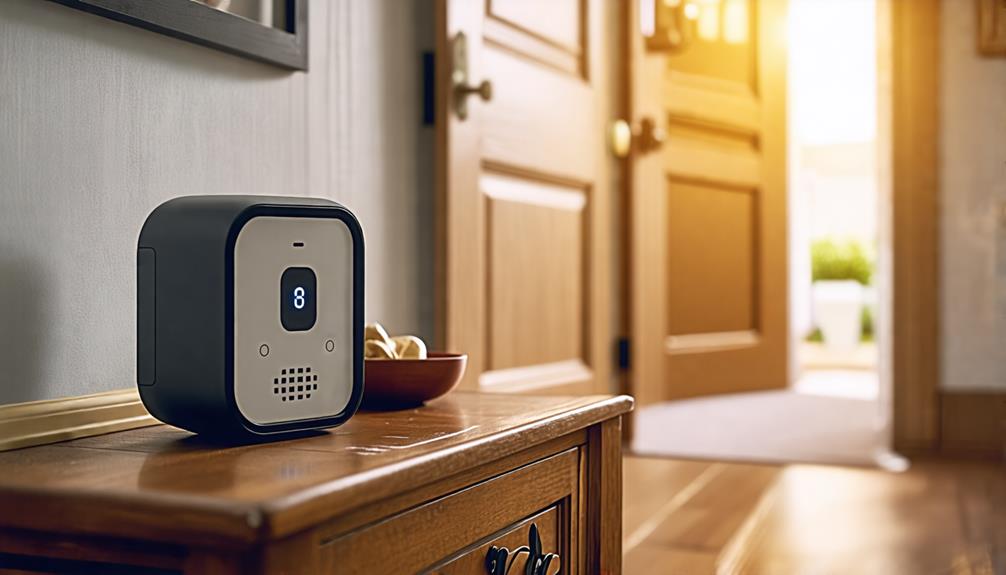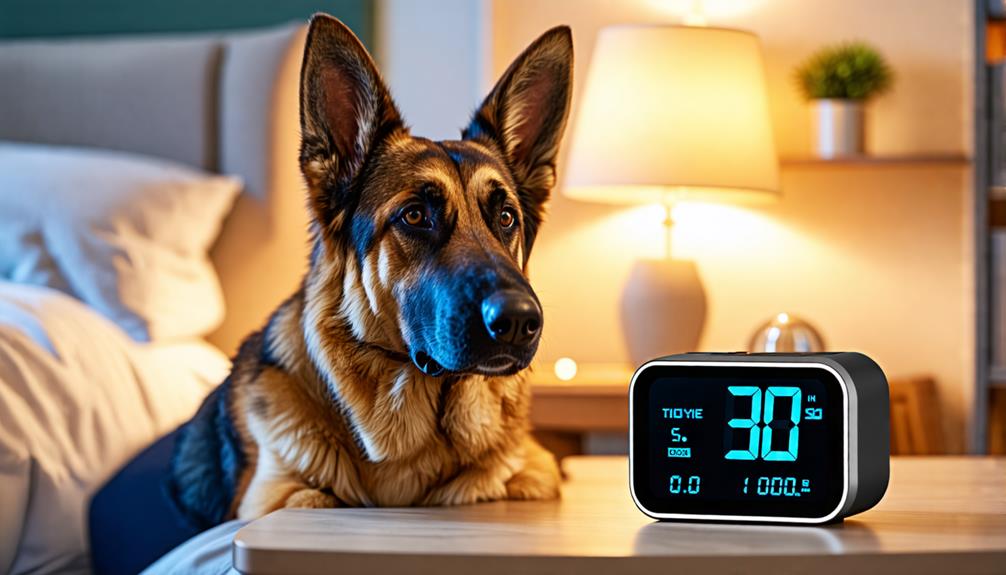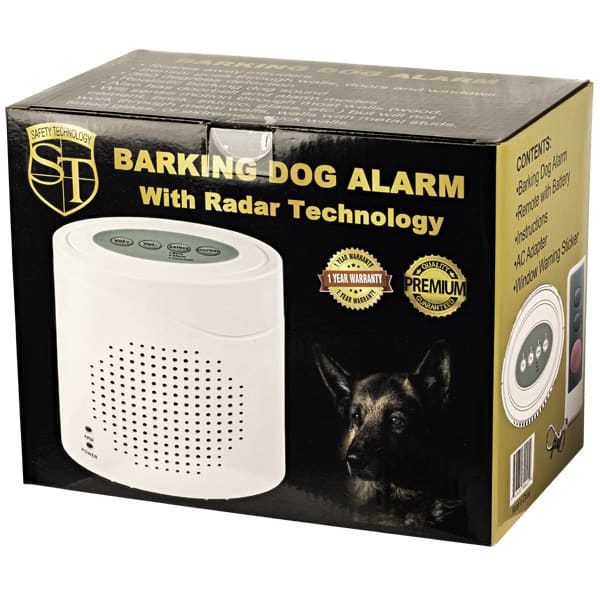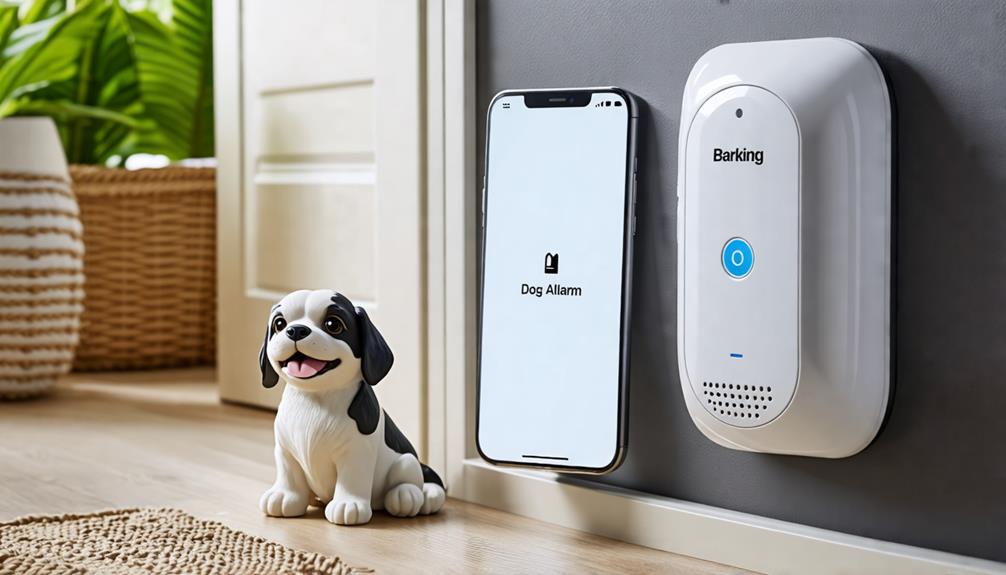
Brainstorm Security Shop

For Orders Over $199

On Any Of Our Products

Details On Refund Page
When you’re setting up a barking dog alarm, it’s crucial to consider not just the sound quality, but where you’ll place the unit for maximum effectiveness. You’ve likely chosen a model that mimics a real dog’s bark, but have you thought about the acoustics of your space? Placement of the barking dog security alarm can dramatically affect how a potential intruder perceives the presence of a dog inside. As you mull over the best spot—whether near main entry points or areas less obvious—think about how sound travels through your home. Curious about how to test these theories and ensure your alarm’s efficacy? Let’s explore some practical steps to optimize your setup.
When selecting the right model of a barking dog alarm, it’s crucial to consider your specific security needs and the layout of your home.
You’ll want to think about dog breed compatibility and the variety of alarm sound options available.
Firstly, dog breed compatibility is key. Different models emulate different breeds, from a Chihuahua’s high-pitched bark to the deep, menacing growl of a German Shepherd.
You should choose a breed sound that best fits the image you want to project. If you live in a compact apartment, a smaller dog’s bark might seem more believable, whereas a large house might benefit from the sound of a bigger, more intimidating breed.
Additionally, consider the alarm sound options. Some models offer a range of barking intensities—from a soft growl to a loud, aggressive bark.
This feature can be particularly useful if you want the alarm to escalate its response based on perceived threat levels, which can deter intruders more effectively.
Opening your barking dog alarm package begins the exciting process of enhancing your home security. As you peel back the layers of packaging, you’ll first encounter the main unit. This is the heart of your system, where the magic of replicating authentic dog behavior comes alive.
You’ll notice it’s designed to mimic the vigilant presence of a guard dog without the hassle of actual pet care.
Next, you’ll find the sensors. These are crucial as they trigger the alarm based on motion detection, integrating seamlessly with the main unit to ensure that any unwanted presence is met with the convincing sound of a barking dog.
It’s these alarm features that contribute to a robust security system, deterring potential intruders effectively.
Also included in the box are the setup instructions and warranty information. Make sure you read through these documents thoroughly to understand how each component contributes to the overall functionality and how they interact to simulate realistic dog behavior.

Before you start setting up your barking dog alarm, gather the necessary tools and materials. You’ll need a few basic items to ensure a smooth installation. First, grab a screwdriver set, as you’ll likely need both Phillips and flathead types.
You’ll also require wire strippers and pliers for handling connections securely. Don’t forget a tape measure for precise placement, ensuring that the dog barking triggers are optimally set to detect movement accurately.
Additionally, it’s wise to have some electrical tape and possibly some screws or mounting hardware, depending on your specific model. If your kit doesn’t come with these, a quick trip to the hardware store should do the trick. Ensure you have extra batteries or a power adapter if your alarm system isn’t hardwired.
The benefits of a well-prepared setup are numerous. A properly installed barking dog alarm can effectively deter intruders, giving you peace of mind. It mimics the sound of a barking dog when triggered, which is a proven deterrent.
The right tools and materials don’t just aid in installation; they ensure that the system functions at its best, maximizing the alarm system benefits. So, double-check your list and make sure you’ve got everything you need!
To determine the optimal placement for your barking dog alarm, start by assessing the main entry points around your home.
You’ll want to consider where intrusions are most likely to occur. Front and back doors are obvious choices, but don’t overlook accessible windows or attached garages. Positioning your alarm near these areas maximizes sound detection, ensuring that it triggers reliably when needed.
Next, evaluate the acoustics of your home. The alarm’s effectiveness depends on its ability to project sound clearly and loudly.
Check for any obstacles that might muffle the sound, such as thick curtains or large furniture. You’ll need a clear path to transmit the sound waves effectively throughout your home.
Also, consider the height at which you mount the alarm. Placing it at ear level can enhance the sound detection capability, making it more likely to scare off an intruder with its realistic barking.
You’re aiming for a balance between visibility to deter potential intruders and discretion to blend with your home aesthetics.
Now that you’ve identified the best spot for your barking dog alarm, it’s time to get it set up.
You’ll need a few tools to ensure a smooth installation, so let’s make sure you have everything ready.
Follow this step-by-step guide to install your alarm efficiently and start enhancing your home security.
Selecting an optimal location for your barking dog alarm is crucial for maximizing its effectiveness. You’ll want to consider both indoor placement and outdoor placement to ensure you’re covering all bases.
For indoor placement, think about the main entry points into your home. You’re aiming to detect any intruder as soon as they attempt entry. Placing the alarm near your front and back doors, or near ground-level windows, can be particularly effective.
Make sure it’s out of reach so it can’t easily be tampered with, but still close enough to the entry points to detect movement.
When it comes to outdoor placement, your garage or shed are prime spots. These areas often house valuable tools or vehicles and are therefore attractive to thieves. Placing an alarm here not only helps protect these valuables but also serves as an early warning system before someone reaches your living spaces.
Always ensure that whatever location you choose, the alarm has a clear line of sight and isn’t blocked by large objects or furniture. This maximizes the sensor’s range and effectiveness.
Before you begin installing your barking dog alarm, gather all the necessary tools to ensure a smooth setup process. Depending on the alarm type and model, the tools required might vary slightly, but there are some common essentials you’ll likely need.
| Tool | Purpose |
|---|---|
| Screwdriver Set | To secure the mounting brackets and adjust components. |
| Drill and Bits | For creating holes for screws in walls or wooden surfaces. |
| Wire Strippers | To prepare any wiring connections for the alarm system. |
Firstly, a screwdriver set is indispensable. Whether your alarm simulates dog behavior or uses a different method for detection, you’ll need various screwdrivers to fit and secure the device properly. Drills and appropriate bits are crucial for firmly attaching the alarm to the chosen location, ensuring it stays stable and functional. Finally, don’t forget wire strippers. Even if your model primarily uses wireless technology, there might be instances where wiring is necessary, especially for power connections.
Gathering these tools beforehand saves you time and frustration, letting you focus solely on the setup when you’re ready to start. Remember, the right tools not only simplify the installation but also impact the overall effectiveness and reliability of your barking dog alarm.
Once you’ve gathered all the necessary tools, you’re ready to start installing your barking dog alarm. First, decide on a strategic location for your device. It should be near the main entry points to monitor effectively. A corner that overlooks the front door or a hallway leading from the garage is ideal.
Next, mount the main unit. Secure it to the wall or a suitable surface using screws or adhesive pads provided with your kit. Make sure it’s positioned so the sensors can optimally detect movement without obstruction.
Now, it’s time to power up your device. Insert batteries or connect the unit to a power source. Once it’s on, you’ll need to sync it with any remote controls or additional sensors. Follow the manufacturer’s instructions to ensure proper setup.
To effectively mimic real dog behavior, adjust the sensitivity and volume controls. Experiment with different settings to find what feels most realistic. Remember, the goal is to deter intruders by simulating authentic dog reactions.
Lastly, test your setup. Walk past the sensor to trigger the alarm. You should hear a convincing bark. Adjust as necessary until you’re satisfied. Using these training techniques ensures that your barking dog alarm behaves just as a real guard dog would.

To ensure your barking dog alarm reacts appropriately, you’ll need to adjust the sensitivity levels. Sensitivity calibration is crucial as it determines how responsive your alarm is to potential intruders versus everyday disturbances.
Start by considering the environmental factors surrounding your home. If you’re in a bustling urban area, you might encounter frequent noises from traffic or pedestrians, which could trigger false alarms if the sensitivity is too high.
Adjust the sensitivity by accessing the alarm system’s settings. You’ll typically find a ‘sensitivity’ or ‘detection’ menu. Here, you can set the threshold that dictates how reactive the alarm should be. If unsure, start at a medium setting and observe if the alarm reacts to general movement around your property without going off unnecessarily.
Be mindful of the seasons too; harsh winds or heavy rain can affect how your alarm behaves. You might need to tweak the settings as the environment changes.
After adjusting the sensitivity levels, it’s crucial to test your barking dog alarm to ensure it operates correctly under various scenarios.
You’ve taken the time to calibrate your system, now let’s make sure it’s up to the task. Alarm testing isn’t just a one-off task; it’s an ongoing part of maintaining the effectiveness of your security measures.
Here are a few steps to guide you through the testing process:

Integrating your barking dog alarm with other security systems enhances your home’s overall safety and efficiency. By connecting it to a broader network like a smart home system, you’re not just relying on the sound of a barking dog to deter intruders, but you’re creating a cohesive and responsive security environment. This type of integration allows your alarm to work in tandem with other security measures, enhancing its effectiveness and ensuring a higher level of protection.
With smart home integration, your barking dog alarm can be synced with cameras, motion sensors, and even your lighting system. This means that when the alarm is triggered, it can simultaneously turn on the lights, record video, and alert you through your smartphone. Here’s a quick breakdown of how integrating your barking dog alarm can enhance your home security:
| Feature | Description | Benefits |
|---|---|---|
| Smart Cameras | Trigger recording when alarm sounds | Visual confirmation, evidence gathering |
| Motion Sensors | Activate alarm upon detection | Early warning, improved response time |
| Smart Lighting | Lights turn on with alarm | Deterrent effect, safer environment |
Ensuring your alarm system compatibility with these devices maximizes your security setup’s efficiency and responsiveness. It’s all about making your system smarter and more interconnected.
To keep your barking dog alarm in top condition, you’ll need to establish a regular cleaning routine and adhere to a battery replacement schedule.
Ensuring the device is clean prevents dust and debris from impairing its functionality.
Meanwhile, replacing the batteries at recommended intervals guarantees that it won’t fail you when you need it most.

Maintaining your barking dog alarm involves a straightforward cleaning routine that keeps it functioning optimally. Regular attention not only extends the life of your device but also ensures it remains effective in securing your home.
Here’s how you can keep your alarm in top shape:
Sticking to this cleaning schedule is crucial for alarm upkeep. It prevents potential malfunctions and false alarms triggered by dirt accumulation.
You’ll find that a little care goes a long way in maintaining your peace of mind. Remember, a clean alarm is a reliable one.
Keeping your barking dog alarm in working order requires timely battery replacement. You’ve got to be aware of the battery types suitable for your device to maximize the alarm lifespan. Typically, these alarms use either standard alkaline batteries or long-lasting lithium batteries. It’s crucial to check the manufacturer’s specifications to ensure you’re using the right type.
Usually, you should replace the batteries at least once a year. However, if your alarm sees frequent use or is set in a high-traffic area, you might need to change them more often.
Don’t wait until the alarm fails to act; a non-functional alarm when you least expect it defeats the purpose of having one.
To keep on top of this, mark your calendar for a routine check every six months. During these checks, listen to the alarm’s sound quality and watch for any signs of weakening or inconsistency.
If the alarm sounds faint or doesn’t activate as quickly as usual, it’s time for a battery swap.
Yes, you can temporarily silence your alarm. Most models include features that allow you to do so.
Usually, you’ll find a button or option in the settings menu to pause the alarm‘s function. This is handy if you’re expecting guests or just need a break from the noise.
When considering burglary prevention, it’s crucial to evaluate how effective alarm technology is against seasoned burglars.
While no system is foolproof, incorporating alarms that mimic real-life responses, like barking dogs, can be surprisingly effective.
These alarms don’t just alert you; they create the illusion of active security measures, which can deter burglars looking for an easy target.
You’ll find this approach can significantly enhance your home’s defense against potential break-ins.
You’re probably wondering how long your alarm batteries will last. Typically, the battery lifespan ranges from 6 to 12 months, depending on usage and quality.
It’s smart to check your device’s manual for specific details. For easy maintenance, consider replacement options like rechargeable batteries or a backup power source to ensure continuous operation.
Always have a spare set handy to avoid any unexpected lapses in protection. Regular checks will help you stay prepared.
You’re right to consider your pets’ well-being when choosing an alarm.
Many systems now offer pet-friendly options that minimize distress. These alarms are designed with pet behavior and sound sensitivity in mind, using frequencies less likely to bother your animals.
It’s best to look for models specifically labeled as pet-safe, or consult with a professional about the best choices for a household with sensitive animals.
Your pets’ comfort is crucial.
Yes, you can adjust the alarm volume to suit smaller spaces.
Most models come with volume controls that let you manage the sound level based on your space considerations.
This feature ensures the noise doesn’t overwhelm your area or cause discomfort.
Now that you’ve set up your barking dog alarm, you’re all set to enhance your home’s security. Remember to regularly check and adjust the sensitivity settings to keep them optimal. Don’t forget to integrate the alarm with your other security measures for a robust defense. By maintaining the device as recommended, you’ll ensure it remains effective and reliable. Rest easier knowing your proactive steps are keeping your home safe and sound.

Brainstorm Security Shop
1867 Caravan Trail
Ste 105
Jacksonville, FL 32216
Call us toll free: (800) 859-5566